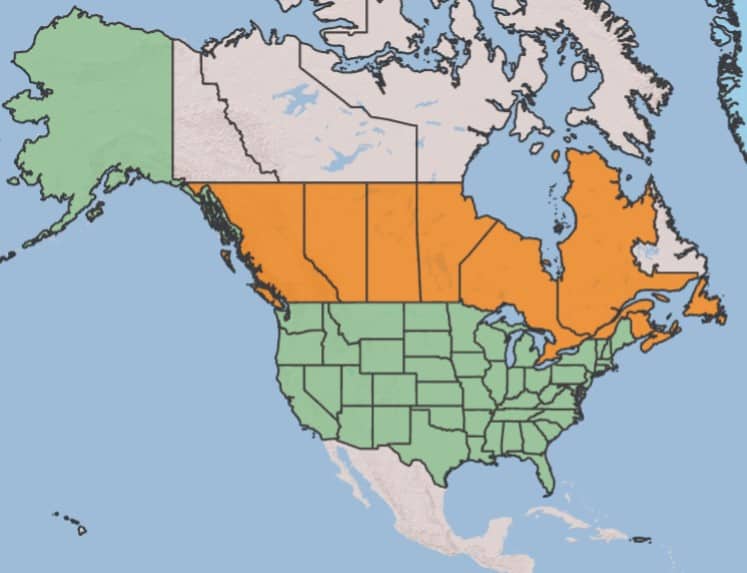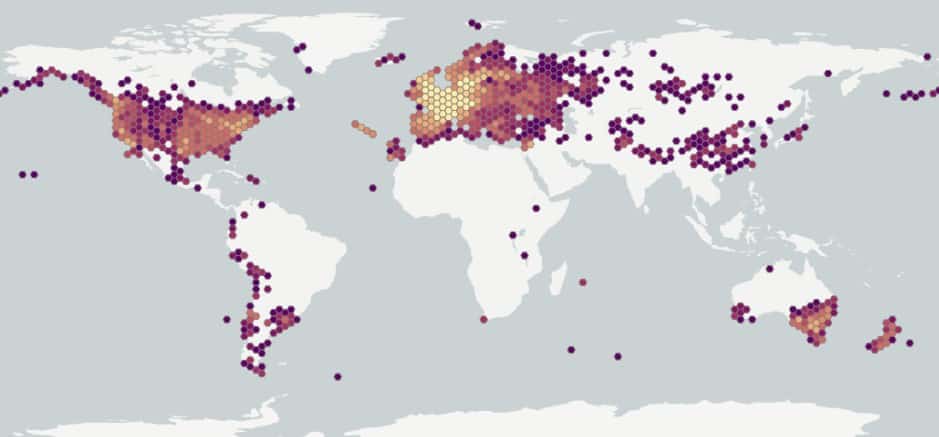Galium aparine
Overview
Aperçu
Regulation :
Remarques Réglementation:
- CFIA Weed Seeds Order - Class 3: Secondary Noxious Weed Seeds
- Quarantine lists of countries e.g. Mexico *may be updated without notice
- USA Federal Noxious Weed Seed List
Regulation Notes:
Included under Galium spp. on the USA Federal Noxious Weed Seed List
Distribution :
Répartition :
Native to Eurasia and North America and widely naturalized, found in temperate zones throughout the world and at higher altitudes in the tropics (Holm et al. 1977; Malik and Vanden Born 1988; USDA-ARS 2022). Occurs throughout North America from Alaska to the east coast (Holm et al. 1977; Malik and Vanden Born 1988; USDA-NRCS 2022), with both native and introduced populations present in Canada except in Nunavut and the Yukon Territory (Brouillet et al. 2010+).
Habitat and Crop Association :
Habitat et Cultures Associées :
Galium aparine is found in arable land, particularly in Triticum aestivum L. subsp. aestivum (wheat), Hordeum vulgare L. subsp. vulgare (barley) and Secale cereale L. subsp. cereale (rye) fields, along fence rows, and in barnyards and pastures (Holm et al. 1977; Malik and Vanden Born 1988). Also found in deciduous woods, thickets, coastal bluffs, and waste ground (Malik and Vanden Born 1988; Darbyshire 2003). Thrives in moist, well-drained habitats, in loam and sandy loam soils (Malik and Vanden Born 1988).
Economic Use, cultivation area, and Weed Association :
Utilisation économique, zone de culture et association de mauvaises herbes :
Duration of Life Cycle :
Durée du cycle vital:
Annual
Dispersal Unit Type :
Type d’unité de dispersion :
Schizocarp, with 2 mericarps
General Information
RENSEIGNEMENTS GÉNÉRAUX
Galium aparine is believed to be both native and introduced to North America (Brouillet et al. 2010+; USDA-NRS 2021). The plants have been found growing along woodland edges and coastal bluffs, and was not considered an aggressive invader of cultivated land (Moore 1975). This species may have been introduced by early settlers in contaminated seed from Eurasia (Moore 1975; Malik and Vanden Born 1988).
A single plant can produce 300-400 seeds on average with a viability of 2-3 years in the soil (Malik and Vanden Born 1988). The spiny-hooked fruit can be carried and dispersed by adhesion to animal fur or human clothing, and seeds have remained viable after animal ingestion (Malik and Vanden Born 1988).
.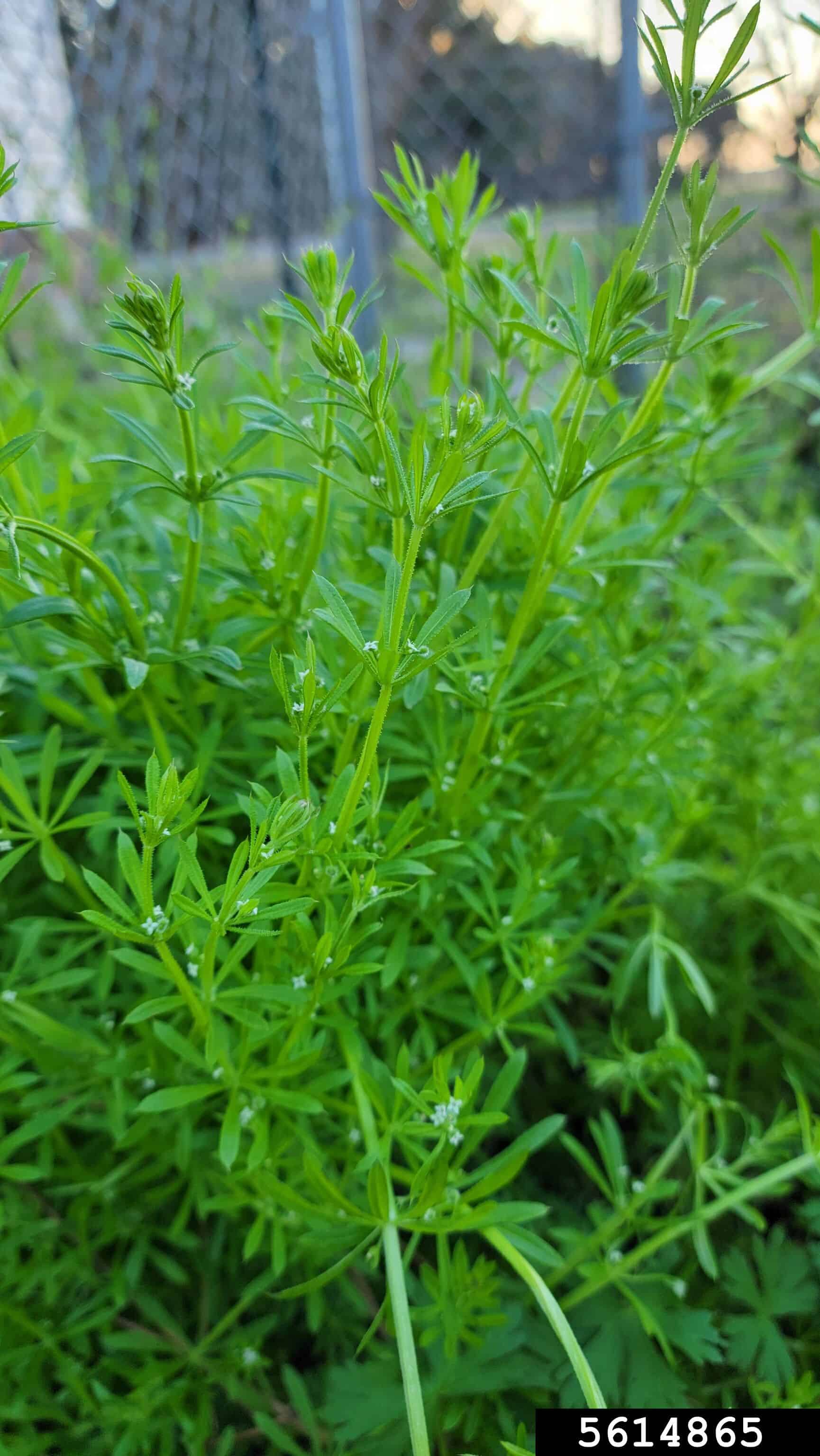
Galium aparine plants (Rebekah D. Wallace, University of Georgia, Bugwood.org)
Identification
Identification
-
Mericarp
Size
- Mericarp diameter*: 1.6 – 3.2 mm excluding bristles
From additional sources:
- Mericarp length: 2 – 4 mm excluding bristles (Malik and Vanden Born 1988)
- Mericarp length: 2.8 – 4 mm, excluding bristles (Moore 1975)
*Note: minimum and maximum of 20 mericarps in a normal range of this species using image measurement (ISMA 2020)
Shape
- Mericarp is globose or oval with a large, round hole on one side
Surface Texture
- Mericarp surface is generally covered in hooked bristles with warty tuberculate bases
- The hooked bristles are about 0.8 mm long (Malik and Vanden Born 1988)
- Mericarps can be smooth textured or tuberculate without bristles
Colour
- Mericarp is dull grey, greyish-brown or dark brown with white bristles
Other Features
- Schizocarp with two mericarps, attached at the large hole on one side of the mericarps, each of which has one seed (Malik and Vanden Born 1988)
- The hole on one side of the mericarp is generally round
- The hole may be covered by the thin mericarp wall, but is generally removed during processing
- Mericarps may develop with a smooth or warty tuberculate surface without bristles; these have been described as G. aparine L. forma intermedium (Bonnet) R.J. Moore (Moore 1975)
- The commonly encountered mericarps with hooked bristles are G. aparine L. forma aparine (Moore 1975)
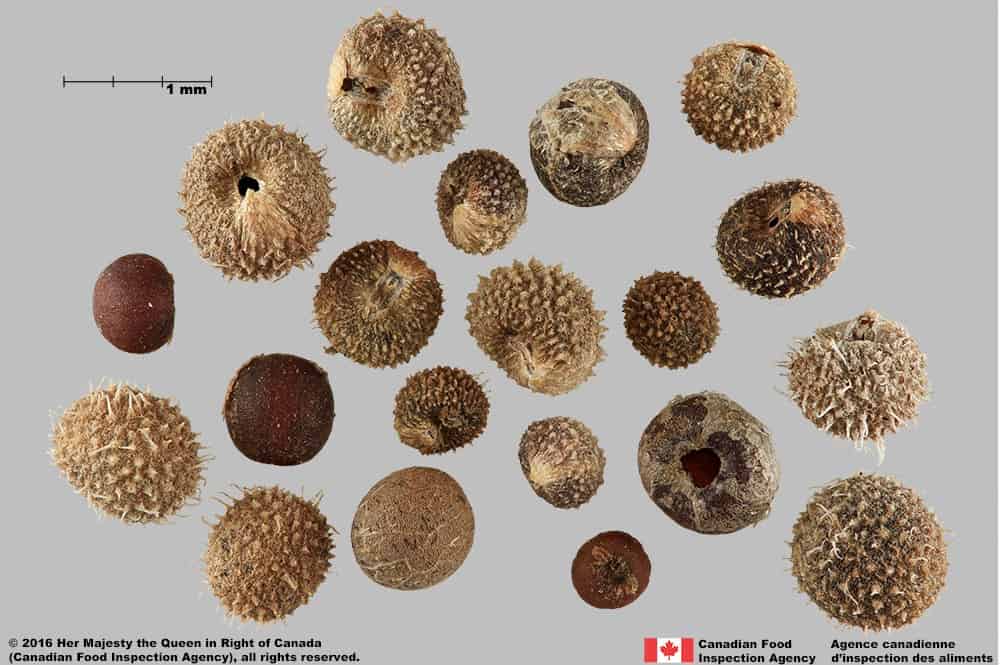
Cleavers (Galium aparine) fruits

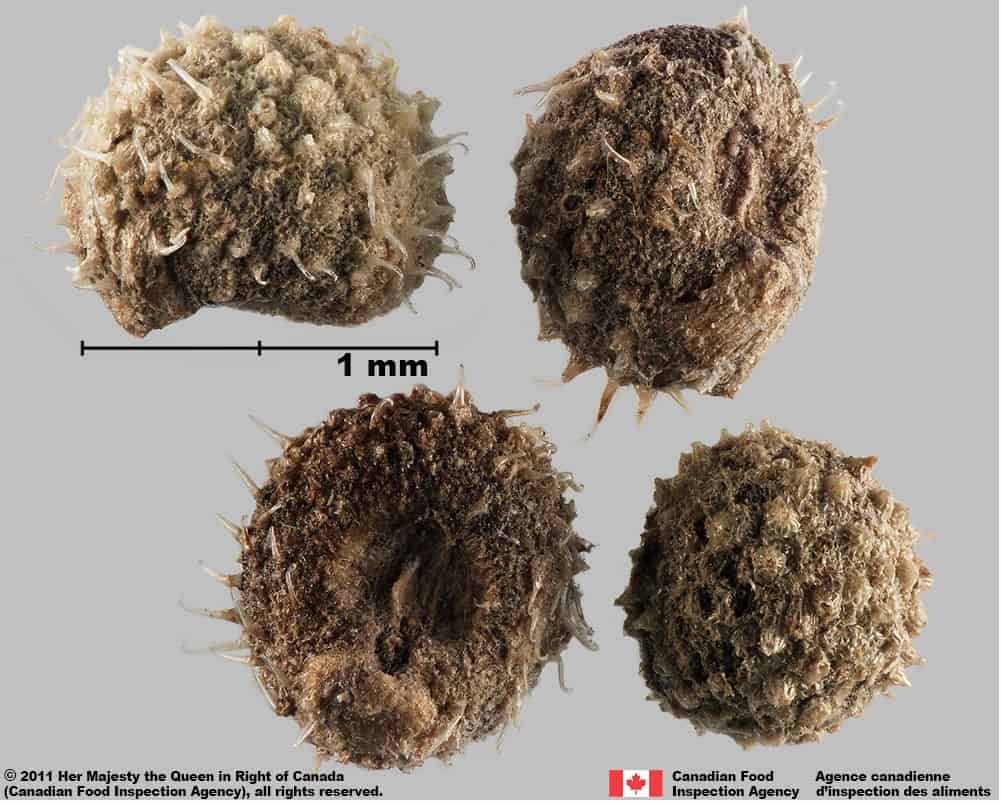
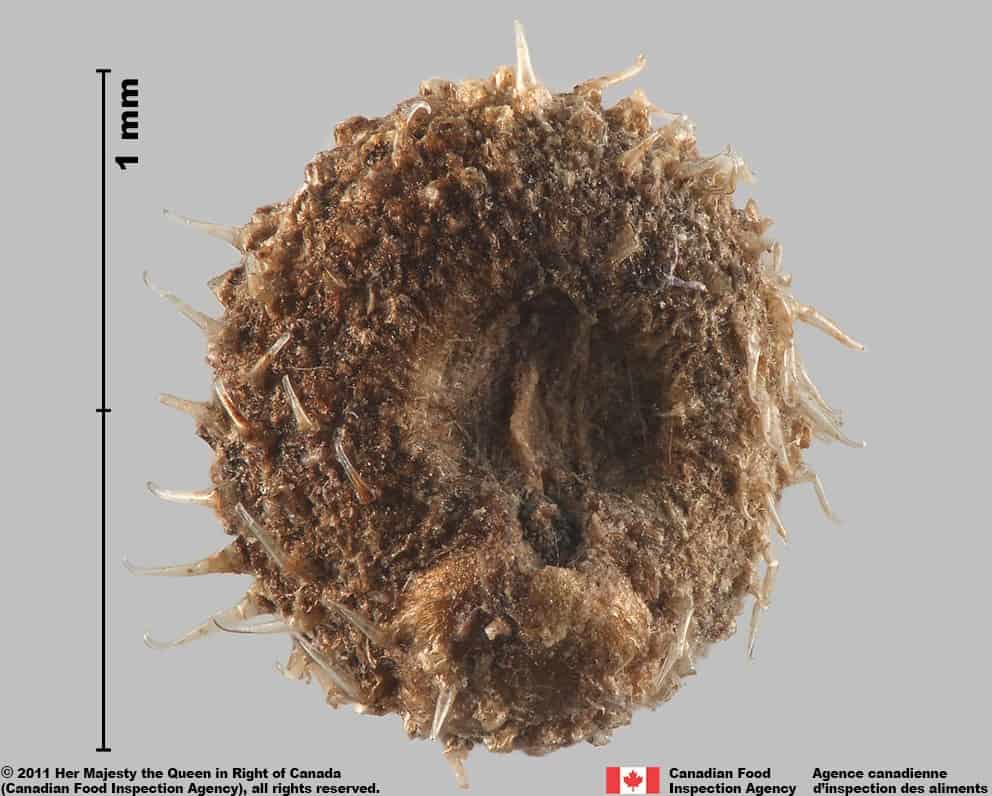
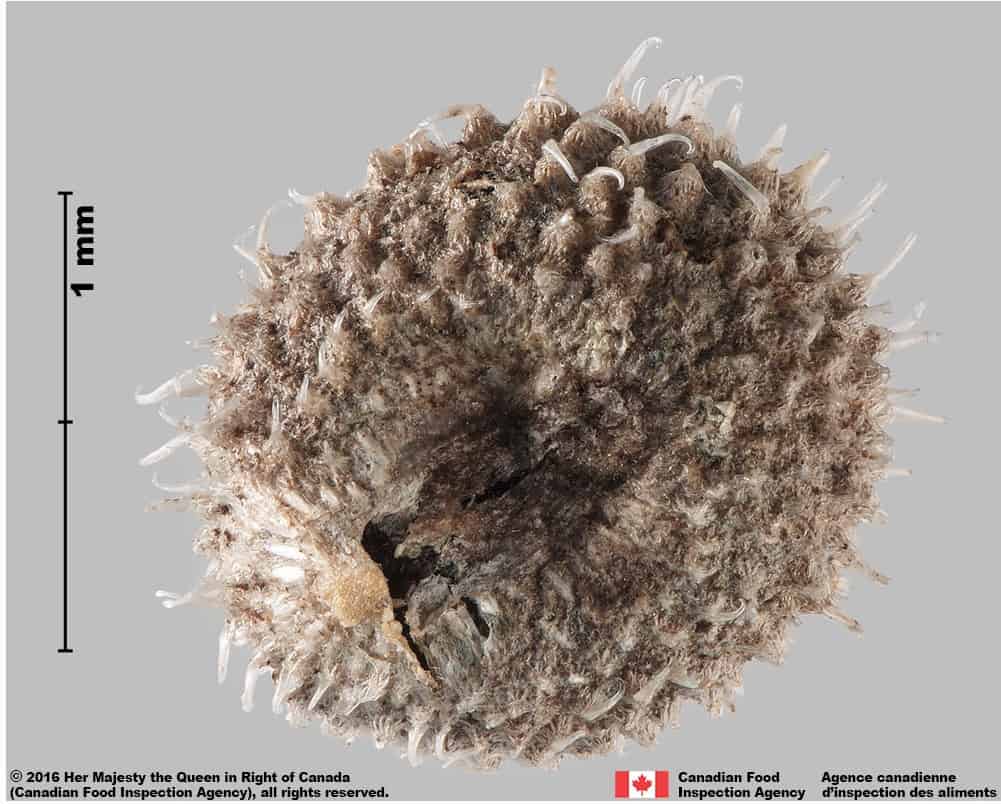
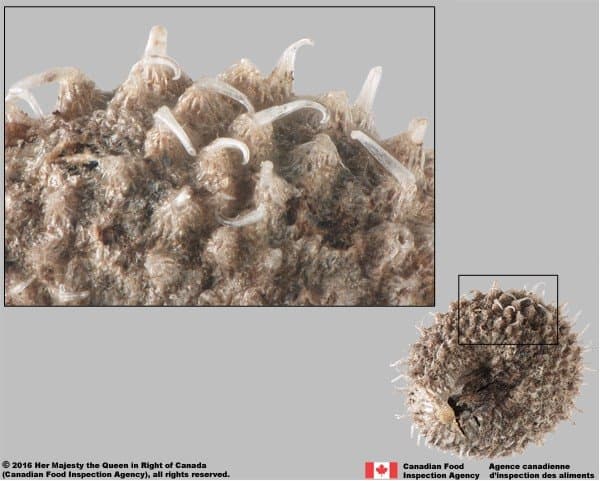
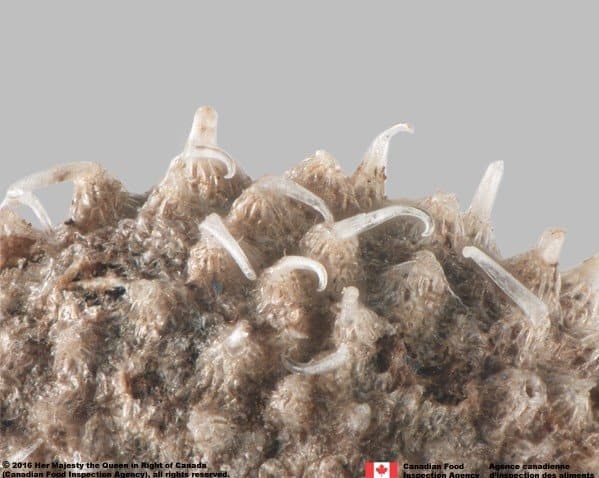
-
Seed
Size
- Seed diameter: 2.8–4.5 mm (Khalik et al. 2008)
Shape
- Seed shape is globose or oval with a round hole on one side
Surface Texture
- Seed surface with a layer of thin tissue in a ridged reticulate pattern
- The reticulation interspaces are generally rectangular shaped and arranged in rows (Khalik et al. 2008)
Colour
- Seed is a translucent greyish or brownish colour
Other Features
Hilum and Hilum area
- Hilum is within the large hole on one side of the seed
-
Embryo
Size
- Embryo size is rudimentary
Shape
- Embryo is spatulate shaped (Martin 1946)
Endosperm
- Endosperm is hard and translucent grey coloured
Other Features
- Embryo is in a peripheral position, along the side of the seed opposite the hole
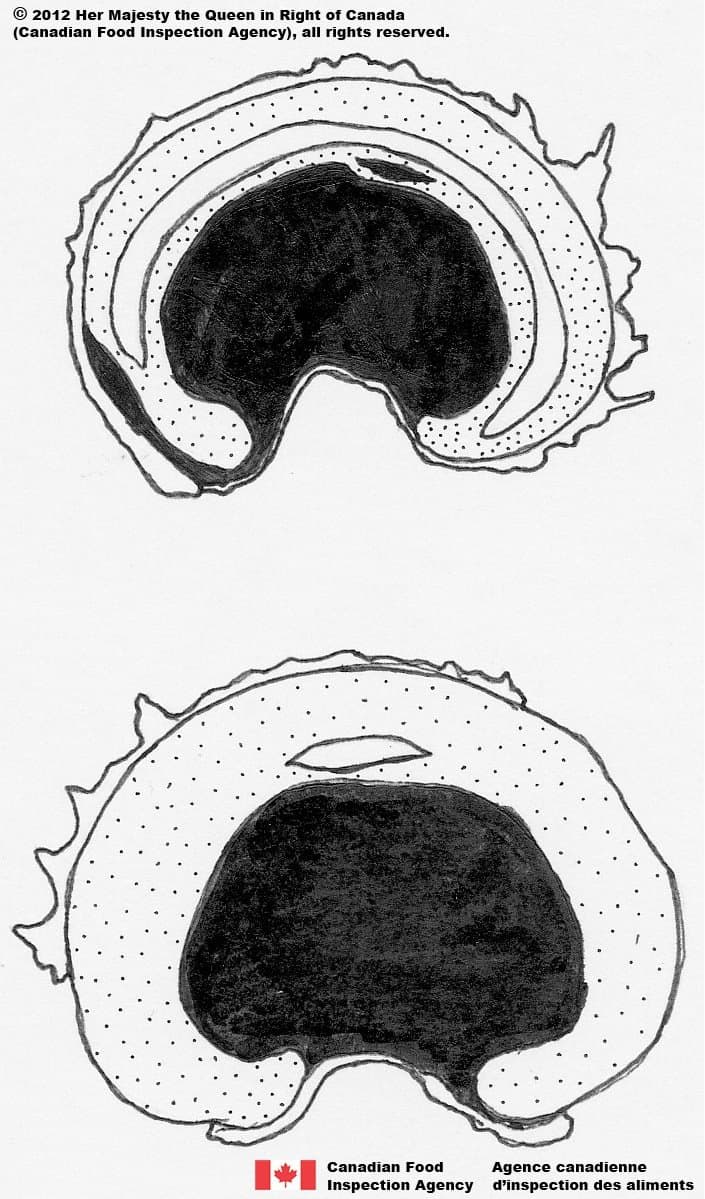
Cleavers (Galium aparine) fruit, cross-section

Identification Tips
CONSEILS POUR L’IDENTIFICATION
Galium species have similar looking mericarps: generally globose with a large hole on one of its sides. The mericarps often have a bristly surface, but some are smooth or tuberculate, and can be variable within a species. Mericarps of different species can be distinguished by their size, surface texture and shape of the hole on one side of the mericarp.
The mericarps of G. aparine are medium to large-sized for the genus, with a typical surface texture of hooked bristles, but this texture can be variable. The mericarps look similar to other medium-sized species with a bristly surface such as G. spurium, and can be distinguished by a generally larger mericarp with hooked bristles arising from a warty tuberculate base, and a round shaped hole on one side of the mericarp. The reticulation pattern with rectangular interspaces on the seed surface may also be used for identification (Khalik et al. 2008). The G. aparine base chromosome number of x = 11 differs from the base number of x = 10 for G. spurium (Moore 1975; Malik and Vanden Born 1988).

Cleavers (Galium aparine) fruit and tubercles






Additional Botany Information
AUTRES RENSEIGNEMENTS BOTANIQUES
Flowers/Inflorescence
- Flowers are tiny, have four lobes, are 2 mm in diameter and white in colour, 3-5 in axillary clusters on stalks (Malik and Vanden Born 1988)
Vegetative Features
- Stem is square with ribs lined with downward-curving spines (Malik and Vanden Born 1988)
- Leaves are arranged in whorls of four to eight along the stem (Malik and Vanden Born 1988)
- Leaves are up to 30-60 mm long and 3-8 mm wide (Malik and Vanden Born 1988)
- Stem nodes are generally woolly-hairy (Moore 1975)
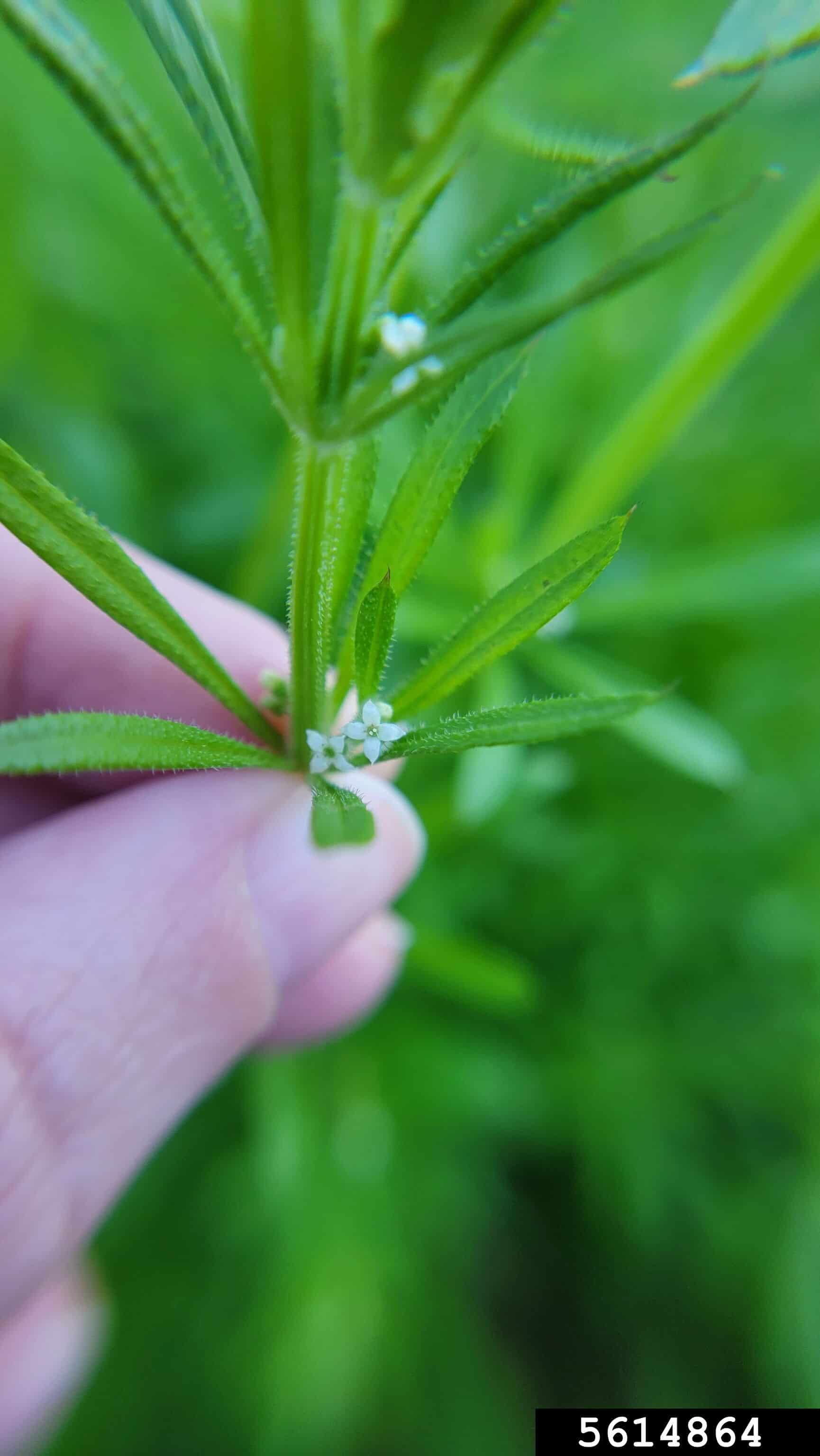
Galium aparine flowers (Rebekah D. Wallace, University of Georgia, Bugwood.org)


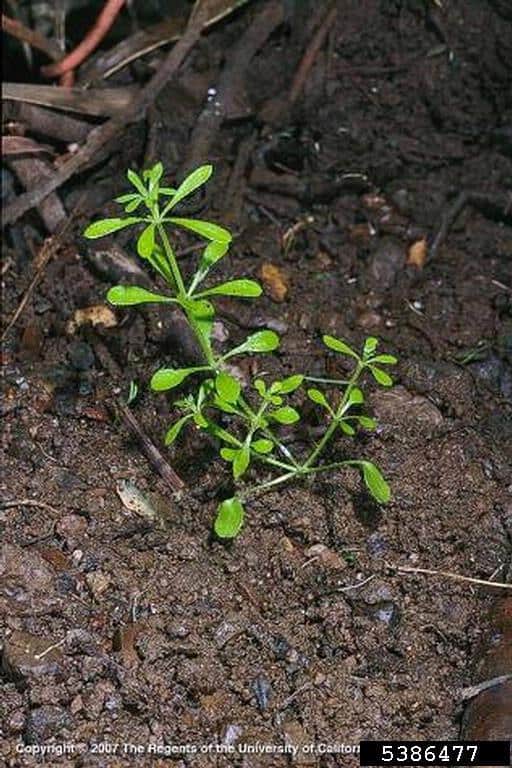
Similar Species
ESPÈCES SEMBLABLES
Similar species are based on a study of seed morphology of various species, and those with similar dispersal units are identified. The study is limited by physical specimen and literature availability at the time of examination, and possibly impacted by the subjectivity of the authors based on their knowledge and experience. Providing similar species information for seed identification is to make users aware of similarities that could possibly result in misidentification.
Galium spurium L. (false cleavers)
Galium spurium (diameter*: 1.4 – 2.4 mm) mericarps are generally smaller than G. aparine, the bristles do not have tuberculate bases, and the hole is generally oval-shaped compared to the tuberculate-based hairs and the round-shaped hole of G. aparine mericarps. G. spurium seed surface has ridged reticulation with polygonal interspaces, surface of G. aparine seeds have rectangular interspaces (Kalik et al. 2008).
Occasional G. aparine mericarps may develop without bristles (G. aparine forma intermedium), and G. spurium mericarps may develop weak bristles on the surface (G. spurium forma vaillantii), and may require other mericarp and seed features to distinguish them.
*Note: minimum and maximum of 20 mericarps in a normal range of this species using image measurement (ISMA 2020)
Click to select species
Cliquez pour sélectionner les espèces
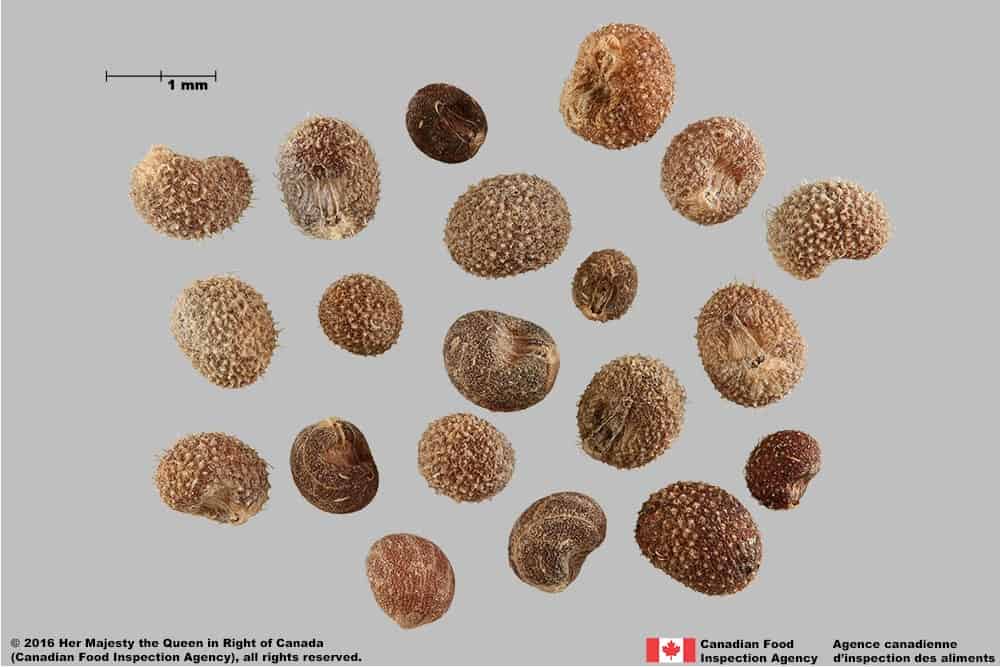
Galium spurium
Comparison Window
Fenêtre de comparaison
MAIN SPECIES
ESPÈCES PRINCIPALES
Galium aparine

Galium aparine
Rubiaceae
Cleavers (Galium aparine) fruits
MAIN SPECIES
ESPÈCES PRINCIPALES
Galium aparine

Galium aparine
Rubiaceae
Cleavers (Galium aparine) fruits
MAIN SPECIES
ESPÈCES PRINCIPALES
Galium aparine

Galium aparine
Rubiaceae
Cleavers (Galium aparine) fruit
MAIN SPECIES
ESPÈCES PRINCIPALES
Galium aparine

Galium aparine
Rubiaceae
Cleavers (Galium aparine) fruit
MAIN SPECIES
ESPÈCES PRINCIPALES
Galium aparine

Galium aparine
Rubiaceae
Cleavers (Galium aparine) fruit and tubercles
MAIN SPECIES
ESPÈCES PRINCIPALES
Galium aparine

Galium aparine
Rubiaceae
Cleavers (Galium aparine) fruit, close-up of surface
MAIN SPECIES
ESPÈCES PRINCIPALES
Galium aparine

Galium aparine
Rubiaceae
Cleavers (Galium aparine) fruit, cross-section
SIMILAR SPECIES
ESPÈCES SEMBLABLES
Galium spurium

Galium spurium
Rubiaceae
False cleavers (Galium spurium) mericarps
SIMILAR SPECIES
ESPÈCES SEMBLABLES
Galium spurium
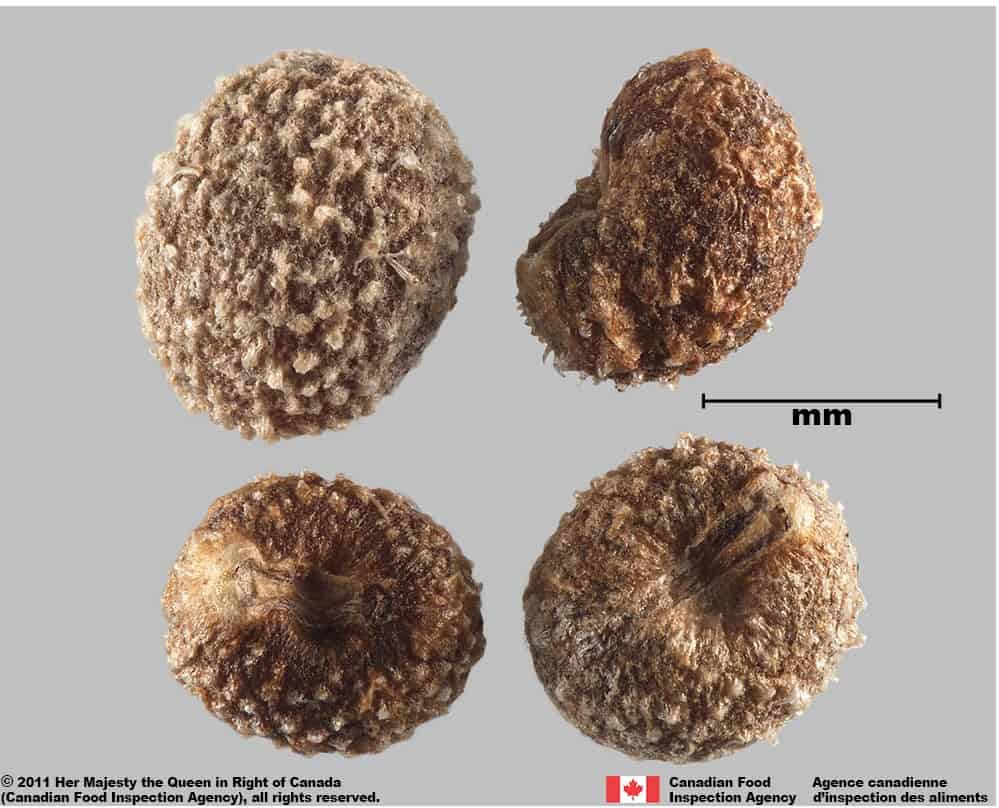
Galium spurium
Rubiaceae
False cleavers (Galium spurium) mericarps
SIMILAR SPECIES
ESPÈCES SEMBLABLES
Galium spurium
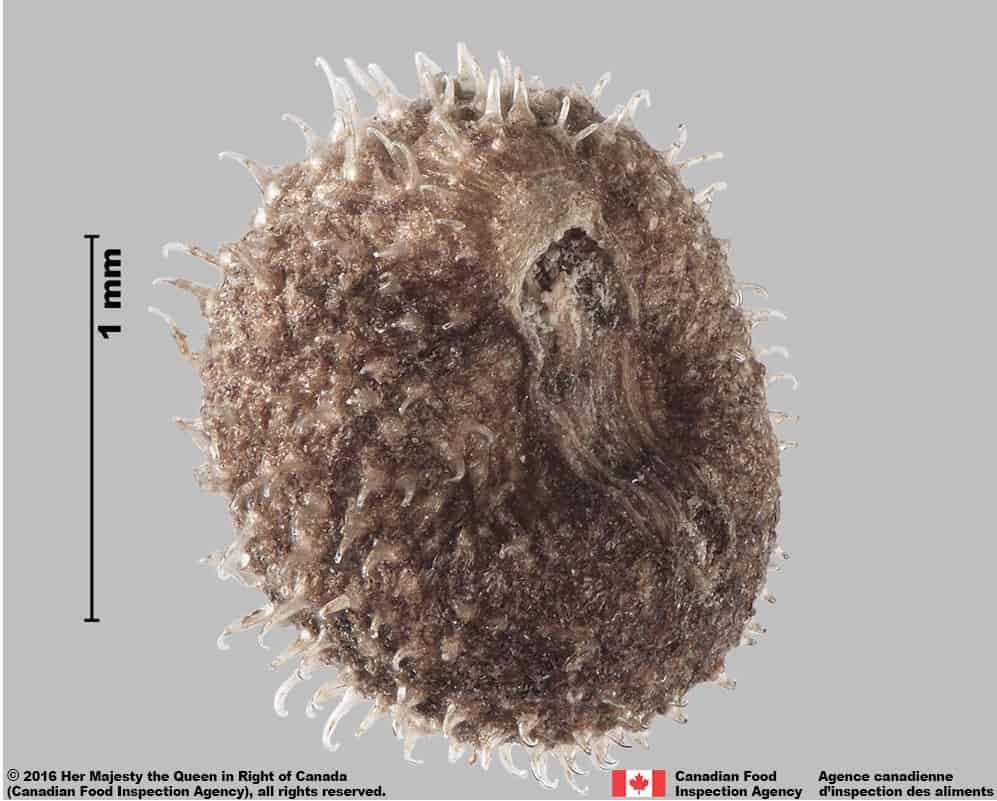
Galium spurium
Rubiaceae
False cleavers (Galium spurium) mericarp
Need ID Help?
Besoin d’aide pour l’identification?
Reference(s)
Référence(s)
Brouillet, L., Coursol, F., Meades, S. J., Favreau, M., Anions, M., Bélisle, P. and Desmet, P. 2010+. VASCAN, the database of vascular plants of Canada. http://data.canadensys.net/vascan/ Accessed March 28, 2022.
Centre for Agriculture and Bioscience International (CABI). 2022. Invasive Species Compendium, CAB International, Wallingford, UK. https://www.cabidigitallibrary.org/journal/cabicompendium Accessed February 28, 2022.
Darbyshire, S. J. 2003. Inventory of Canadian Agricultural Weeds. Agriculture and Agri-Food Canada, Research Branch. Ottawa, ON.
Global Biodiversity Information Facility (GBIF) Secretariat. 2022. https://doi.org/10.15468/39omei Accessed via https://www.gbif.org/species/2913548 Accessed December 29, 2022.
Government of Canada (GC). 2016. Canadian Weed Seeds Order. https://laws-lois.justice.gc.ca/eng/regulations/SOR-2016-93/page-2.html (English) https://laws-lois.justice.gc.ca/fra/reglements/DORS-2016-93/page-2.html (French)
Holm, L.G., Plucknett, D.L., Pancho, J.V. and Herberger, J.P. 1977. The World’s Worst Weeds: Distribution and Biology. Krieger Publishing Company, Florida, United States. 609 pp.
International Seed Morphology Association (ISMA). 2020. Method for Seed Size Measurement. Version 1.0. ISMA Publication Guide.
Khalik, K.A , Abd El-Ghani, M. and El Kordy, A. 2008. Fruit and seed morphology in Galium L. (Rubiaceae) and its importance for taxonomic identification. Acta Botanica Croatica, 67: 1-20.
Malik, N. and Vanden Born, W. H. 1988. The biology of Canadian weeds. 86. Galium aparine L. and Galium spurium L. Canadian Journal of Plant Science 68: 481-499.
Martin, A.C. 1946. The comparative internal morphology of seeds. The American Midland Naturalist 36: 513-660.
Moore, R. J. 1975. The Galium aparine complex in Canada. Canadian Journal of Botany 53: 877-893.
Tropicos. 2022. Missouri Botanical Garden. https://tropicos.org Accessed February 28, 2022
U.S. Department of Agriculture-Agricultural Research Services (USDA-ARS). 2022. Germplasm Resources Information Network (GRIN), https://npgsweb.ars-grin.gov/gringlobal/taxon/taxonomysimple.aspx Accessed March 28, 2022.
U.S. Department of Agriculture-Natural Resources Conservation Service (USDA-NRCS). 2022. The PLANTS Database. National Plant Data Team, Greensboro, NC USA. http://plants.usda.gov Accessed December 29, 2022.



